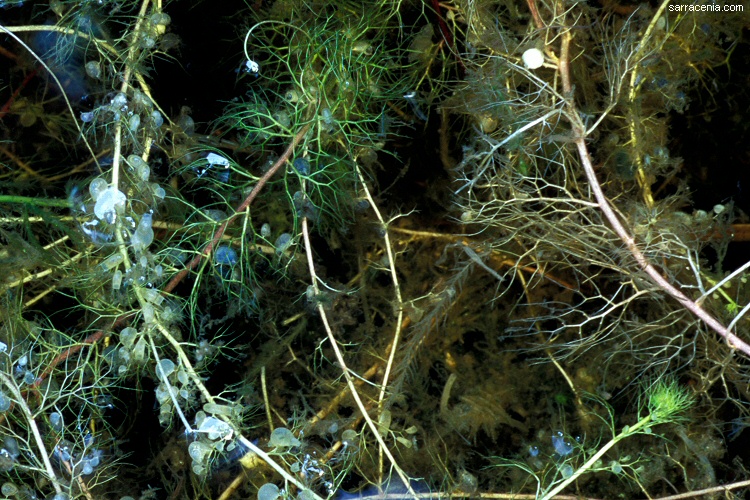
The "Aha!" moment:
But then I made the crucial observation...
Do you see that bright, overexposed blob at the upper right part of the image--the
brightest element in the photograph? That is not a reflection, rather it is a specialized type of flower
that does not have petals and never opens up. It never even emerges from the water. Instead, it
hangs underwater on a short pedicel and produces seed without ever being pollinated. Only one North American species produces such
aquatic cleistogamous flowers: Utricularia geminiscapa! (This interesting feature is
the origin of the specific epithet.) Unfortunately, there were no normal (chasmogamous) flowers present.
You can see
another cleistogamous flower in the previous photograph, right near the top of the image, but it is submerged several cm beneath the
water surface and so looks kind of
fuzzy. Even so, it has an interesting heartshaped outline.
The range of Utricularia geminiscapa is restricted to the eastern part of North America; from the mid-Atlantic USA
states north up to Nova Scotia, and around the great lakes to as far west as Iowa. Although it has a fairly large range,
it is by all reports elusive and never in huge quantity. As this was the first
time I had ever seen it, I was excited. (I had seen the plant once before, but in cultivation at a highly modified pond, so
that time didn't really count.)
OK, I admit that Beth found these plants, not me, but I am far too mature to let that petty thought even enter my mind,
to say nothing about actually having it dwell in my gut so long that I might mention it on a web page written more than
a month after the fact.
Do you notice the curving air-shoot at the top this photo? No one really knows what those are for. I do not have a closer
photograph for air-shoots on U. geminiscapa, but here is one for
an air-shoot on U. macrorhiza.
For your interest, here is another composition of the same plants shown above
that shows a few different features.
Once I got over the excitement of seeing this new species,
the weird morphology that I previously mentioned started niggling at me again. Then I realized what it was:
there was a leaf dimorphism in
the shoots. On each plant, some of the shoots were mostly leafy with some bladders, while others were mostly bladderous with only a
few dissected leaves. For example, in this photograph, compare the very green leafy stolon at top-center or the
pinkish leafy stolon at the upper-right, against the bladderous stolon arcing vertically
along the left third of the image. The dimorphism there is not as strong as in
Utricularia minor or (certainly) U. intermedia, but is similar in degree to the expression
in U. ochroleuca.
I apologize about the less-than-great quality of this and the previous Utricularia geminiscapa photographs. I was not
prepared for taking photographs of aquatics, so had to shoot straight down into the water. Also, the old boardwalk I was on was
only partially bouyant. So as I took these photos, the dock slowly sank under me. When I was
finished, the platform had become submerged by a few cm of water, and had become very, very slick!